Enhanced Photocatalytic Activities of Ag2WO4 Modified Ag6Si2O7 through a Comprehensive p-n Heterojunction S-Scheme Process
Abstract
1. Introduction
2. Experimental Section
2.1. Materials
2.2. Synthesis of Ag6Si2O7
2.3. Synthesis of Ag6Si2O7/Ag2WO4 Composites
2.4. Characterisation
2.5. Photocatalytic Degradation Experiment
3. Results and Discussion
3.1. XRD Analysis
3.2. Morphology and Composition Analyses
3.3. BET Analysis
3.4. XPS Analysis
3.5. UV–vis Optical Properties and Valence Band (VB)/Conduction Band (CB) Potential Positions
3.6. RhB Dye Degradation Analysis
3.7. Electrochemical and Band Position Analysis
3.8. Reactive Species Study
3.9. Photocatalysis Mechanism
4. Conclusions
Supplementary Materials
Author Contributions
Funding
Data Availability Statement
Acknowledgments
Conflicts of Interest
References
- Perera, F. Pollution from fossil-fuel combustion is the leading environmental threat to global pediatric health and equity: Solutions exist. Int. J. Environ. Res. Public Health 2018, 15, 16. [Google Scholar] [CrossRef] [PubMed]
- Obaideen, K.; Shehata, N.; Sayed, E.T.; Abdelkareem, M.A.; Mahmoud, M.S.; Olabi, A.G. The role of wastewater treatment in achieving sustainable development goals (SDGs) and sustainability guideline. Energy Nexus 2022, 7, 100112. [Google Scholar] [CrossRef]
- Nie, G.; Yao, Y.; Duan, X.; Xiao, L.; Wang, S. Advances of piezoelectric nanomaterials for applications in advanced oxidation technologies. Curr. Opin. Chem. Eng. 2021, 33, 100693. [Google Scholar] [CrossRef]
- Bethi, B.; Sonawane, S.H.; Bhanvase, B.A.; Gumfekar, S.P. Nanomaterials-based advanced oxidation processes for wastewater treatment: A review. Chem. Eng. Process. Process Intensif. 2016, 109, 178–189. [Google Scholar] [CrossRef]
- Cardoso, I.M.F.; Cardoso, R.M.F.; da Silva, J.C.G.E. Advanced oxidation processes coupled with nanomaterials for water treatment. Nanomaterials 2021, 11, 2045. [Google Scholar] [CrossRef] [PubMed]
- Skillen, N.; Daly, H.; Lan, L.; Aljohani, M.; Murnaghan, C.W.J.; Fan, X.; Hardacre, C.; Sheldrake, G.N.; Robertson, P.K.J. Photocatalytic reforming of biomass: What role will the technology play in future energy systems. Top. Curr. Chem. 2022, 380, 33. [Google Scholar] [CrossRef]
- Kamble, G.S.; Ling, Y.C. Solvothermal synthesis of facet-dependent BiVO4 photocatalyst with enhanced visible-light-driven photocatalytic degradation of organic pollutant: Assessment of toxicity by zebrafish embryo. Sci. Rep. 2020, 10, 12993. [Google Scholar] [CrossRef]
- Shaban, M.; Rabia, M.; El-Sayed, A.M.A.; Ahmed, A.; Sayed, S. Photocatalytic properties of PbS/graphene oxide/polyaniline electrode for hydrogen generation. Sci. Rep. 2017, 7, 14100. [Google Scholar] [CrossRef]
- Niu, X.; Yan, W.; Zhao, H.; Yang, J. Synthesis of Nb doped TiO2 nanotube/reduced graphene oxide heterostructure photocatalyst with high visible light photocatalytic activity. Appl. Surf. Sci. 2018, 440, 804–813. [Google Scholar] [CrossRef]
- Lu, M.; Wang, X.; Xu, C.; Wang, Y. Synthesis of CdS@ZnO nanocomposites with wide visible light absorption range. J. Mater. Sci. Mater. Electron. 2020, 31, 17624–17632. [Google Scholar] [CrossRef]
- Li, S.; Wang, C.; Liu, Y.; Xue, B.; Chen, X. Photocatalytic degradation of antibiotics using a novel Ag/Ag2S/Bi2MoO6 plasmonic p-n heterojunction photocatalyst: Mineralization activity, degradation pathways and boosted charge separation mechanism. Chem. Eng. J. 2021, 415, 128991. [Google Scholar] [CrossRef]
- Chen, P.; Chen, L.; Ge, S.; Zhang, W.; Wu, M.; Xing, P.; Rotamond, T.B.; Lin, H.; Wu, Y.; He, Y. Microwave heating preparation of phosphorus doped g-C3N4 and its enhanced performance for photocatalytic H2 evolution in the help of Ag3PO4 nanoparticles. Int. J. Hydrog. Energy 2020, 45, 14354–14367. [Google Scholar] [CrossRef]
- Chen, H.; Chen, N.; Feng, C.; Gao, Y. Synthesis of a novel narrow-band-gap iron (II,III) oxide/titania/silver silicate nanocomposite as a highly efficient and stable visible light-driven photocatalyst. J. Colloid Interface Sci. 2018, 515, 119–128. [Google Scholar] [CrossRef]
- Zhang, W.; Xu, D.; Wang, F.; Chen, M. AgCl/Au/g-C3N4 ternary composites: Efficient photocatalysts for degradation of anionic dyes. J. Alloy. Compd. 2021, 868, 159266. [Google Scholar] [CrossRef]
- Guo, B.; Zhao, C.; Zhou, L.; Yu, Z.; Liu, X.; Zhao, Z.; Yuan, H. Constructing a novel multi-hierarchical TiO2/g-C3N4/Ag-AgBr photocatalyst with dual Z-scheme heterojunction utilizing Ag as the charge transfer mediator. J. Alloys Compd. 2022, 900, 163514. [Google Scholar] [CrossRef]
- Jatav, N.; Kuntail, J.; Khan, D.; De, A.K.; Sinha, I. AgI/CuWO4 Z-scheme photocatalyst for the degradation of organic pollutants: Experimental and molecular dynamics studies. J. Colloid Interface Sci. 2021, 599, 717–729. [Google Scholar] [CrossRef]
- Li, Y.; Liu, Y.; Zhang, M.; Zhou, Q.; Li, X.; Chen, T.; Wang, S. Preparation of Ag3PO4/TiO2(B) heterojunction nanobelt with extended light response and enhanced photocatalytic performance. Molecules 2021, 26, 6987. [Google Scholar] [CrossRef]
- Zhou, M.; Tian, X.; Yu, H.; Wang, Z.; Ren, C.; Zhou, L.; Lin, Y.-W.; Dou, L. WO3/Ag2CO3 mixed photocatalyst with enhanced photocatalytic activity for organic dye degradation. ACS Omega 2021, 6, 26439–26453. [Google Scholar] [CrossRef]
- Liu, L.; Hu, T.; Dai, K.; Zhang, J.; Liang, C. A novel step-scheme BiVO4/Ag3VO4 photocatalyst for enhanced photocatalytic degradation activity under visible light irradiation. Chin. J. Catal. 2021, 42, 46–55. [Google Scholar] [CrossRef]
- Rafiq, U.; Majid, K. Mitigating the charge recombination by the targeted synthesis of Ag2WO4/Bi2Fe4O9 composite: The facile union of orthorhombic semiconductors towards efficient photocatalysis. J. Alloys Compd. 2020, 842, 155876. [Google Scholar] [CrossRef]
- Ayappan, C.; Jayaraman, V.; Palanivel, B.; Pandikumar, A.; Mani, A. Facile preparation of novel Sb2S3 nanoparticles/rod-like α-Ag2WO4 heterojunction photocatalysts: Continuous modulation of band structure towards the efficient removal of organic contaminants. Sep. Purif. Technol. 2019, 236, 116302. [Google Scholar] [CrossRef]
- Shi, L.; Gou, J.; Liang, L.; Wang, F.; Sun, J. The crystal phase transformation of Ag2WO4 through loading onto g-C3N4 sheets with enhanced visible-light photocatalytic activity. RSC Adv. 2016, 6, 96861–96869. [Google Scholar] [CrossRef]
- Lou, Z.; Huang, B.; Wang, Z.; Ma, X.; Zhang, R.; Zhang, X.; Qin, X.; Dai, Y.; Whangbo, M.-H. Ag6Si2O7: A silicate photocatalyst for the visible region. Chem. Mater. 2014, 26, 3873–3875. [Google Scholar] [CrossRef]
- Hu, Y.; Zheng, H.; Xu, T.; Xu, N.; Ma, H. Highly efficient Ag6Si2O7/WO3 photocatalyst based on heterojunction with enhanced visible light photocatalytic activities. RSC Adv. 2016, 6, 103289–103295. [Google Scholar] [CrossRef]
- Wen, M.; Yang, N.; Wang, J.; Liu, D.; Zhang, W.; Bian, S.; Huang, H.; He, X.; Wang, X.; Ramakrishna, S.; et al. Activating carbon nitride by BP@Ni for the enhanced photocatalytic hydrogen evolution and selective benzyl alcohol oxidation. ACS Appl. Mater. Interfaces 2021, 13, 50988–50995. [Google Scholar] [CrossRef]
- Zhang, G.; Sun, J.; Chen, D.; Li, N.; Xu, Q.; Li, H.; He, J.; Lu, J. Hierarchical core-shell heterostructures of ZnIn2S4 nanosheets on electrospun In2O3 nanofibers with highly enhanced photocatalytic activity. J. Hazard. Mater. 2020, 398, 122889. [Google Scholar] [CrossRef]
- De Santana, Y.V.B.; Gomes, J.E.C.; Matos, L.; Cruvinel, G.H.; Perrin, A.; Perrin, C.; Andres, J.; Varela, J.A.; Longo, E. Silver molybdate and silver tungstate nanocomposites with enhanced photoluminescence. Nanomater. Nanotechnol. 2014, 4, 22. [Google Scholar] [CrossRef]
- Sreedevi, A.; Priyanka, K.P.; Babitha, K.K.; Sankararaman, S.I.; Thomas, V. Synthesis and characterization of silver tungstate/iron phthalocyanine nanocomposite for electronic applications synthesis and characterization of silver tungstate/iron phthalocyanine nanocomposite for electronic applications. Eur. Phys. J. B 2017, 90, 102. [Google Scholar] [CrossRef]
- Alvarez-Roca, R.; Gouveia, A.F.; De Foggi, C.C.; Lemos, P.S.; Gracia, L.; Da Silva, L.F.; Vergani, C.E.; San-Miguel, M.; Longo, E.; Andres, J. Selective synthesis of α-, β-, and γ-Ag2WO4 polymorphs: Promising platforms for photocatalytic and antibacterial materials. Inorg. Chem. 2021, 60, 1062–1079. [Google Scholar] [CrossRef]
- Ghobadifard, M.; Mohebbi, S. Novel nanomagnetic Ag/β-Ag2WO4/CoFe2O4 as a highly efficient photocatalyst under visible light irradiation. New J. Chem. 2018, 42, 9530–9542. [Google Scholar] [CrossRef]
- Hsu, M.H.; Chang, C.J. Ag-doped ZnO nanorods coated metal wire meshes as hierarchical photocatalysts with high visible-light driven photoactivity and photostability. J. Hazard. Mater. 2014, 278, 444–453. [Google Scholar] [CrossRef] [PubMed]
- Andrés, J.; Gracia, L.; Gonzalez-Navarrete, P.; Longo, V.M.; Avansi, W., Jr.; Volanti, D.P.; Ferrer, M.M.; Lemos, P.S.; La Porta, F.A.; Hernandes, A.C.; et al. Structural and electronic analysis of the atomic scale nucleation of Ag on α-Ag2WO4 induced by electron irradiation. Sci. Rep. 2014, 4, 5391. [Google Scholar] [CrossRef] [PubMed]
- Chen, P.; Xing, P.; Chen, Z.; Hu, X.; Lin, H.; Zhao, L.; He, Y. In-situ synthesis of AgNbO3/g-C3N4 photocatalyst via microwave heating method for efficiently photocatalytic H2 generation. J. Colloid Interface Sci. 2019, 534, 163–171. [Google Scholar] [CrossRef] [PubMed]
- Chen, Z.; Deng, Y.; Tang, L.; Feng, C.; Wang, J.; Yu, J.; Wang, J.; Liu, Z.; Zhou, H. Theoretical and experimental study of full spectrum response Z-scheme 0D/2D Ag6Si2O7/CN photocatalyst with enhanced photocatalytic activities. Appl. Surf. Sci. 2020, 514, 145963. [Google Scholar] [CrossRef]
- Liu, D.; Huang, W.; Li, L.; Liu, L.; Sun, X.; Liu, B.; Yang, B.; Guo, C. Experimental and theoretical investigation on photocatalytic activities of 1D Ag/Ag2WO4 nanostructures. Nanotechnology 2017, 28, 385702. [Google Scholar] [CrossRef]
- Hong, Y.; Jiang, Y.; Li, C.; Fan, W.; Yan, X.; Yan, M.; Shi, W. In-situ synthesis of direct solid-state Z-scheme V2O5/g-C3N4 heterojunctions with enhanced visible light efficiency in photocatalytic degradation of pollutants. Appl. Catal. B Environ. 2016, 180, 663–673. [Google Scholar] [CrossRef]
- Wang, L.; Chen, L.; Tang, M.; Jiang, S.; Gao, D. Incorporation of a Z-scheme AgI/Ag6Si2O7 heterojunction to PET fabric for efficient and repeatable photocatalytic dye degradation. New J. Chem. 2022, 46, 22550–22560. [Google Scholar] [CrossRef]
- Sabri, M.; Habibi-Yangjeh, A.; Chand, H.; Krishnan, V. Heterogeneous photocatalytic activation of persulfate ions with novel ZnO/AgFeO2 nanocomposite for contaminants degradation under visible light. J. Mater. Sci. Mater. Electron. 2021, 32, 4272–4289. [Google Scholar] [CrossRef]
- Ma, Y.; Wang, Q.; Xing, S. Insight into the catalytic mechanism of γ-Fe2O3/ZnFe2O4 for hydrogen peroxide activation under visible light. J. Colloid Interface Sci. 2018, 529, 247–254. [Google Scholar] [CrossRef]
- Cui, Y.; Li, M.; Zhu, N.; Cheng, Y.; Lam, S.S.; Chen, J.; Gao, Y.; Zhao, J. Bi-based visible light-driven nano-photocatalyst: The design, synthesis, and its application in pollutant governance and energy development. Nano Today 2022, 43, 101432. [Google Scholar] [CrossRef]
- Assis, M.; Robeldo, T.; Foggi, C.C.; Kubo, A.M.; Minguez-Vega, G.; Condoncillo, E.; Beltran-Mir, H.; Torres-Mendieta, R.; Andres, J.; Oliva, M.; et al. Ag Nanoparticles/α-Ag2WO4 composite formed by electron beam and femtosecond irradiation as potent antifungal and antitumor agents. Sci. Rep. 2019, 9, 9927. [Google Scholar] [CrossRef] [PubMed]
- Zhang, W.; Ma, Y.; Zhu, X.; Wang, L.; Ye, J.; Hou, X.; Liu, S.; Lu, M.; Tian, H.; Hu, X. In situ synthesis of α-Fe2O3/LaFeO3 modified with g-C3N4 and Ti3C2 for construction of multiple Z-scheme/Schottky heterojunctions as an efficient visible-light photocatalyst for Cr (VI) reduction and organic pollutants removal. J. Alloys Compd. 2022, 913, 165217. [Google Scholar] [CrossRef]
- Jo, W.-K.; Kumar, S.; Eslava, S.; Tonda, S. Construction of Bi2WO6/RGO/g-C3N4 2D/2D/2D hybrid Z-scheme heterojunctions with large interfacial contact area for efficient charge separation and high-performance photoreduction of CO2 and H2O into solar fuels. Appl. Catal. B Environ. 2018, 239, 586–598. [Google Scholar] [CrossRef]
- Fu, J.; Xu, Q.; Low, J.; Jiang, C.; Yu, J. Ultrathin 2D/2D WO3/g-C3N4 step-scheme H2-production photocatalyst. Appl. Catal. B Environ. 2019, 243, 556–565. [Google Scholar] [CrossRef]
- Huang, H.; Zhao, J.; Du, Y.; Zhou, C.; Zhang, M.; Wang, Z.; Weng, Y.; Long, J.; Hofkens, J.; Steele, J.A.; et al. Direct Z-scheme heterojunction of semicoherent FAPbBr3/Bi2WO6 interface for photoredox reaction with large driving force. ACS Nano 2020, 14, 16689–16697. [Google Scholar] [CrossRef]
- Zhang, L.; Zhang, J.; Yu, H.; Yu, J. Emerging S-scheme photocatalyst. Adv. Mater. 2022, 34, 2107668. [Google Scholar] [CrossRef]
- Mei, F.; Li, Z.; Dai, K.; Zhang, J.; Liang, C. Step-scheme porous g-C3N4/Zn0.2Cd0.8S-DETA composites for efficient and stable photocatalytic H2 production. Chin. J. Catal. 2020, 41, 41–49. [Google Scholar] [CrossRef]
- Ke, X.; Zhang, J.; Dai, K.; Fan, K.; Liang, C. Integrated S-Scheme Heterojunction of Amine-Functionalized 1D CdSe Nanorods Anchoring on Ultrathin 2D SnNb2O6 Nanosheets for Robust Solar-Driven CO2 Conversion. Sol. RRL 2021, 5, 2000805. [Google Scholar] [CrossRef]
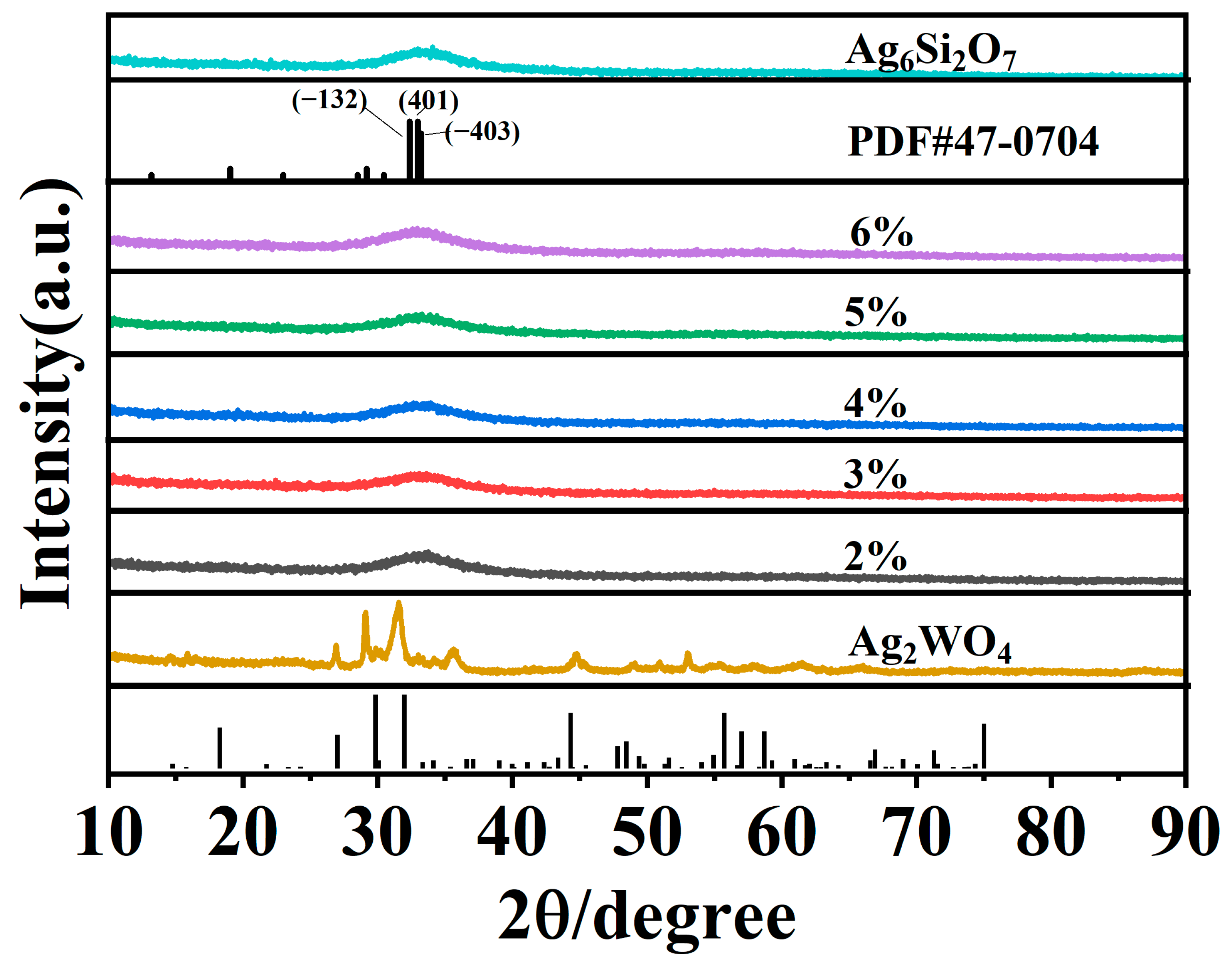
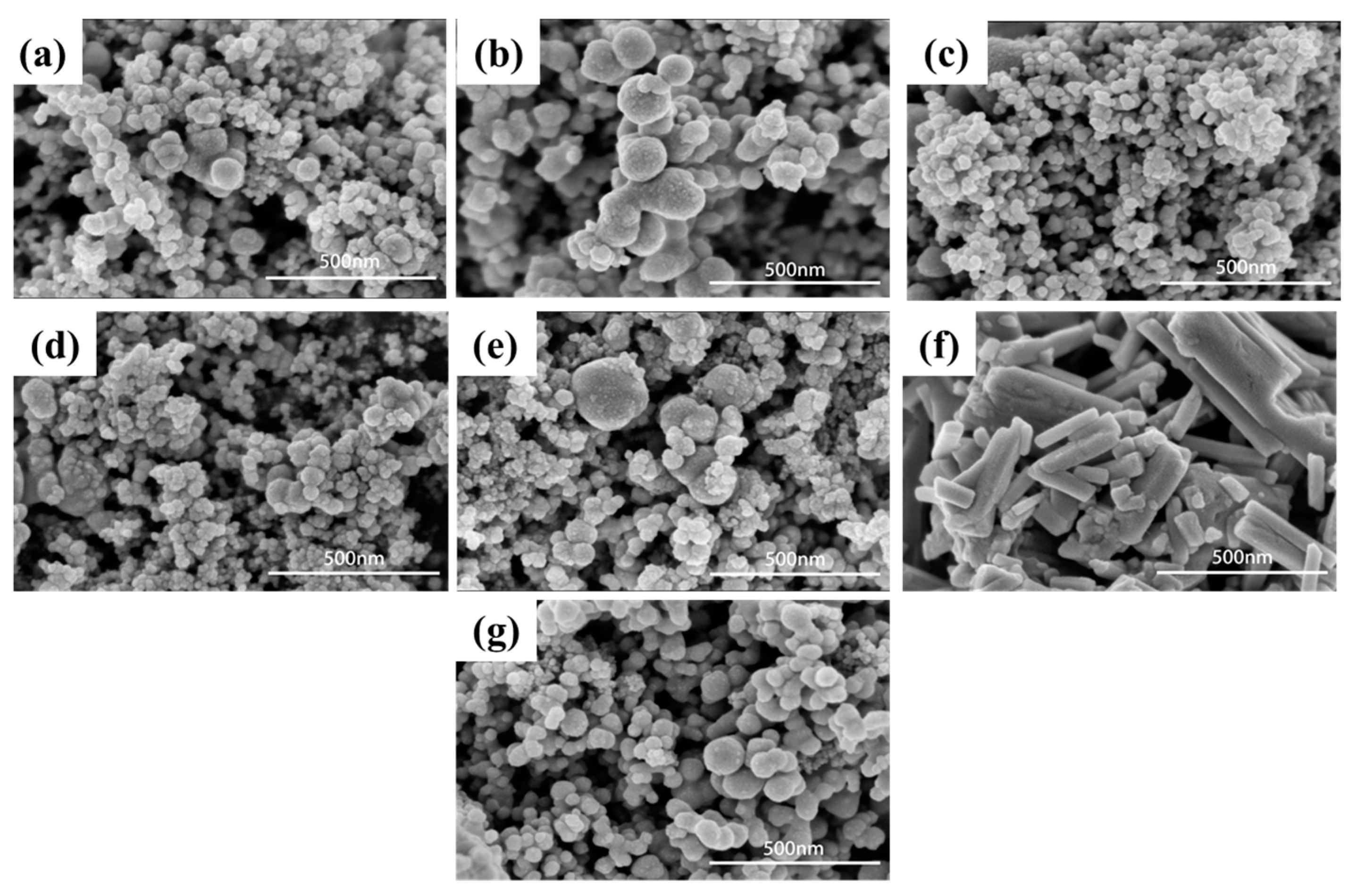

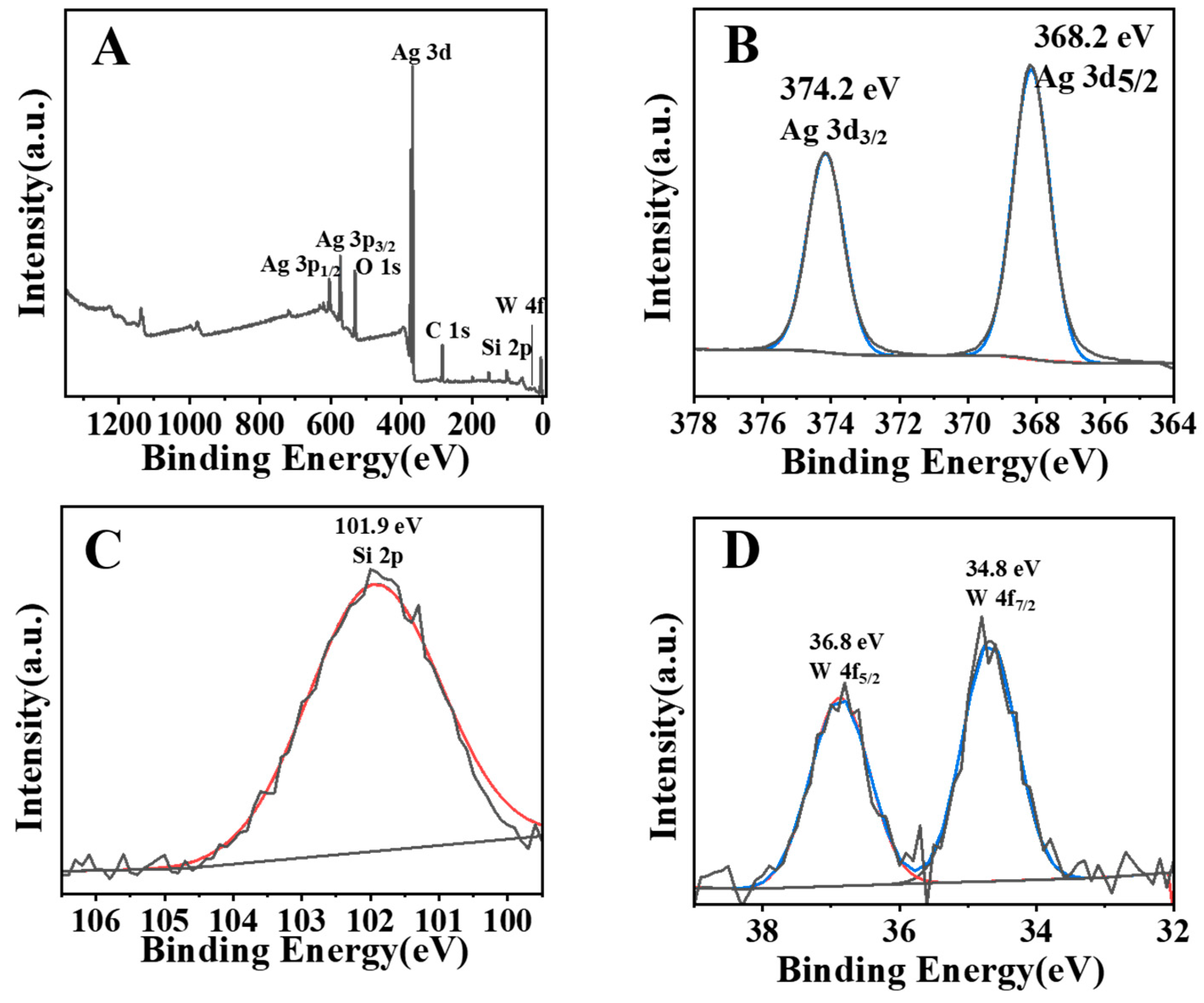
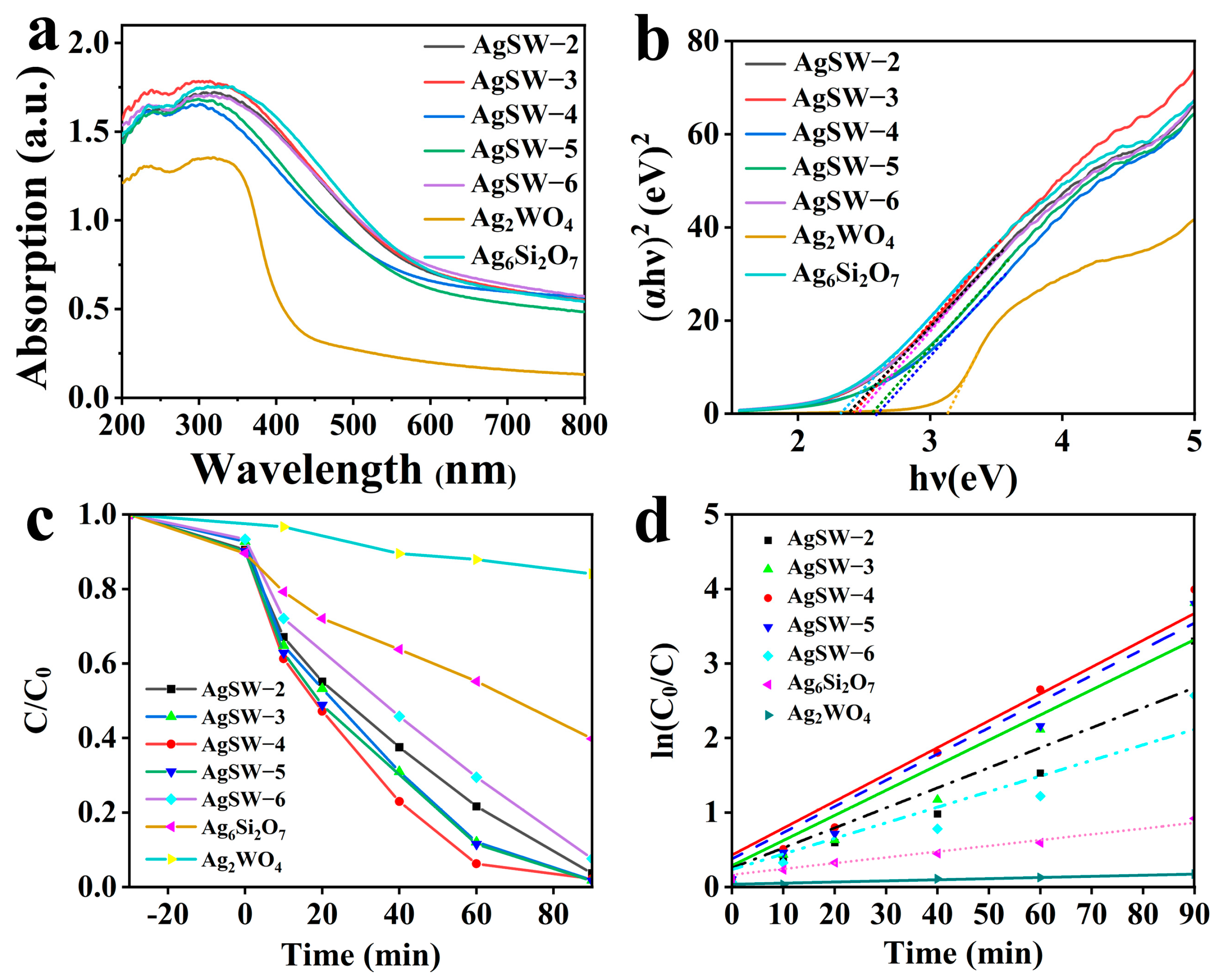
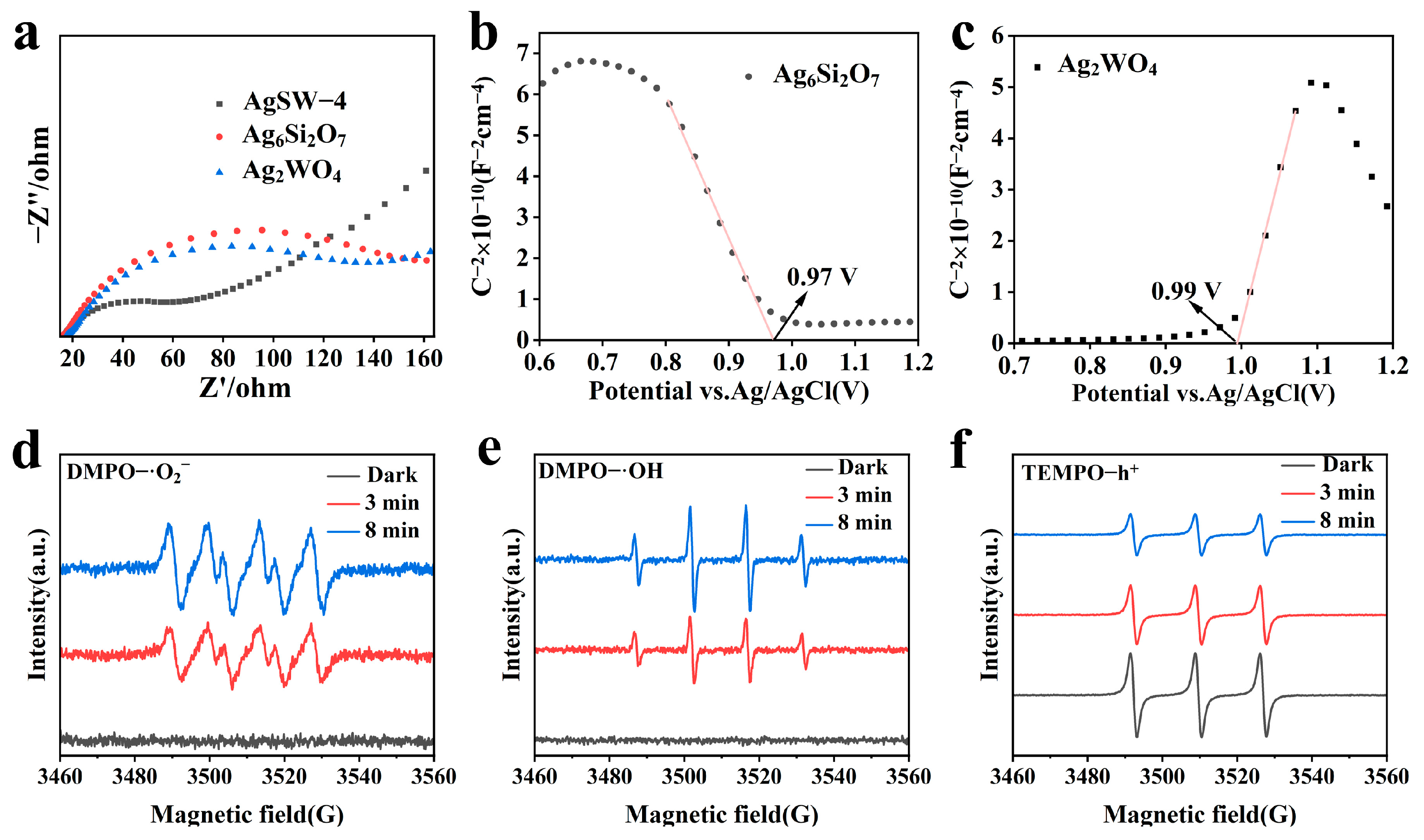

| Serial Number | Samples | BET Surface Area (m2/g) |
|---|---|---|
| 1 | AgSW-2 | 14.0788 |
| 2 | AgSW-3 | 13.5775 |
| 3 | AgSW-4 | 15.0416 |
| 4 | AgSW-5 | 12.4154 |
| 5 | AgSW-6 | 14.3216 |
| 6 | Ag2WO4 | 0.9141 |
| 7 | Ag6Si2O7 | 12.9647 |
| Serial Number | Bandgap | Samples |
|---|---|---|
| 1 | Ag2WO4 | 3.12 eV |
| 2 | Ag6Si2O7 | 2.31 eV |
| 3 | AgAW-2 | 2.38 eV |
| 4 | AgSW-3 | 2.42 eV |
| 5 | AgSW-4 | 2.61 eV |
| 6 | AgSW-5 | 2.56 eV |
| 7 | AgSW-6 | 2.46 eV |
Disclaimer/Publisher’s Note: The statements, opinions and data contained in all publications are solely those of the individual author(s) and contributor(s) and not of MDPI and/or the editor(s). MDPI and/or the editor(s) disclaim responsibility for any injury to people or property resulting from any ideas, methods, instructions or products referred to in the content. |
© 2023 by the authors. Licensee MDPI, Basel, Switzerland. This article is an open access article distributed under the terms and conditions of the Creative Commons Attribution (CC BY) license (https://creativecommons.org/licenses/by/4.0/).
Share and Cite
Shah, N.H.; Li, M.; Zhang, P.; Cui, Y.; Wang, Y. Enhanced Photocatalytic Activities of Ag2WO4 Modified Ag6Si2O7 through a Comprehensive p-n Heterojunction S-Scheme Process. Crystals 2023, 13, 633. https://doi.org/10.3390/cryst13040633
Shah NH, Li M, Zhang P, Cui Y, Wang Y. Enhanced Photocatalytic Activities of Ag2WO4 Modified Ag6Si2O7 through a Comprehensive p-n Heterojunction S-Scheme Process. Crystals. 2023; 13(4):633. https://doi.org/10.3390/cryst13040633
Chicago/Turabian StyleShah, Navid Hussain, Mengke Li, Ping Zhang, Yanyan Cui, and Yaling Wang. 2023. "Enhanced Photocatalytic Activities of Ag2WO4 Modified Ag6Si2O7 through a Comprehensive p-n Heterojunction S-Scheme Process" Crystals 13, no. 4: 633. https://doi.org/10.3390/cryst13040633
APA StyleShah, N. H., Li, M., Zhang, P., Cui, Y., & Wang, Y. (2023). Enhanced Photocatalytic Activities of Ag2WO4 Modified Ag6Si2O7 through a Comprehensive p-n Heterojunction S-Scheme Process. Crystals, 13(4), 633. https://doi.org/10.3390/cryst13040633






